Tea Staining Baskets
When I started weaving someone told me about using tea to stain baskets. It is still one of my favorite ways to finish basket, I love the rich color and I like the smell of the tea brewing. I especially like that this is a non-toxic way to finish a basket.
There are a couple of different methods, here’s how I do it.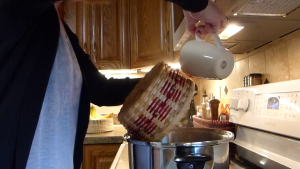
What do you need?
Cheap tea (I usually buy a box of 100 tea bags at the dollar store)
Water
Ammonia (be sure it is NOT sudsy ammonia)
A big pot – (Dutch oven or stock pot)
A stove or hotplate
A new garbage bag.
A slotted spoon or something to remove the tea bags with
Where should you do this?
Ahhh – a non-toxic finish for baskets! You can do this in the kitchen!
Put about a gallon of water in your pot. Bring it to a boil. Add about 50 tea bags. Let it boil for five minutes.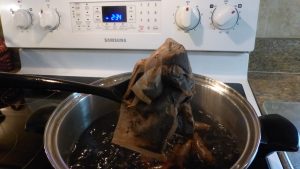
Use the slotted spoon to scoop out the tea bags.
Use the ladle or mug to pour the hot tea over your basket. You may also dip the basket, but do not soak the basket. Just make sure every part of the basket gets touched with the tea. It will not look very dark – it will mostly look wet.
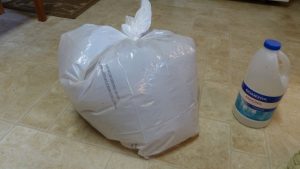 When the basket has been completely covered with tea, put it in the garbage bag with about a ¼ cup of ammonia. Tie the bag closed. Shake.
When the basket has been completely covered with tea, put it in the garbage bag with about a ¼ cup of ammonia. Tie the bag closed. Shake.
The basket will remain in the bag for 1 – 1 ½ hours. Every fifteen minutes shake the bag.
Remove the basket and let it dry completely. I usually do this part outside. It will be food safe when dry.
A wood handle may need a bit of sanding with some steel wool.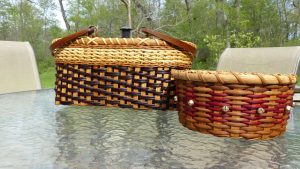
Why does this work?
The color you see is the tannin in the tea. The ammonia is acting as a fixative or mordant.
For those of you interested – ammonia is not a true mordant, but it ‘acts’ as a mordant with tea because it adjusts the PH.
And there’s more than one way to Tea Stain a basket
My friend Regina, keeps a covered container of tea with some ammonia in her garage. The container is large enough to dip baskets.
She takes her baskets and dips them, lets them dry – and repeats if she wants the basket a little darker.
I asked her for a recipe – how much tea, water, ammonia. She says it’s an experiment. She just adds more water and ammonia and tea bags when needed. Her baskets are beautiful. Maybe you are brave enough to do it her way 🙂
You can also use instant tea. Make up a batch of tea, dip the basket and toss into a garbage bag with ammonia.
To Tea Stain or not to Tea Stain
Tea staining works great on reed or rattan.
I do not suggest using this on basket with wood bases, or baskets made with wood. The process saturates the material which can break wood bases. The tannin in the tea can react with the tannin in the wood, the end result of which is black and not a pretty black. I have used it with success on oak handles, but not much success on any other wood.
I would also suggest not tea staining metal. You will notice I removed the bells from the Christmas basket after it was dry – the process discolored the metal and left black marks on the basket.
Also – if you have dyed reed in the basket, consider that tea staining is like adding another color. If you are using black tea, it will add a little bit of orange. It is beautiful on reds and browns and even some greens, but it makes blues and purples kind of muddy.
If you are interested in patterns for any of the baskets pictured in this blog, just click on its photo. Except for Farmer’s Market – this is a new basket and the pattern is still in process.


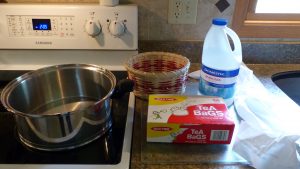
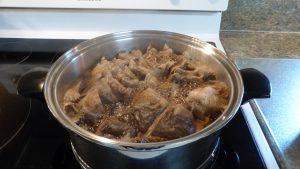
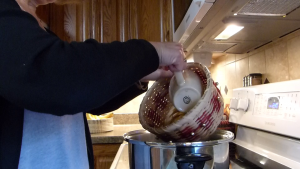
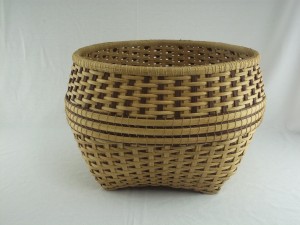
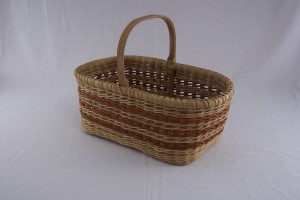
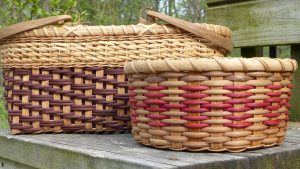

I am worried about dyed reed in a basket I might like to try this technique of tea staining on. Won’t the dyed reed run?
Sherry,
I have not had problems with the dyed reed running. You really don’t need to make the basket very wet with the tea, and the ammonia/tea tannin is a chemical reaction. I have used it with a lot of different colors over the years with out problems.
I have always mixed my instant tea/water/ammonia together and used in a spray bottle. I would recommend making it in small batches and using it up as to not develop any mold. Also if you are concerned you can always wear a mask while spraying, then let dry. Depending on the amount of mixture you use and how dark you want it; you may want to apply another coat.
Other than a few colors (turquoise and magenta) I have not had trouble with bleeding.
Has anyone use it in a spray bottle?
I’ve heard it works, but it’s best with the ammonia added to the tea mixture. I’ve never tried it (misting ammonia is not appealing :)) and I’ve never seen the results, so I didn’t include it.
IF someone has tried it we would love to hear how it turned out.
I like the idea of this. Got to try it.
Love your classes. You are are wonderfully patient
Teacher!
I have also used this method with acorns, walnut or pecans.. Place nuts in an old panty hose. about 2 cups. Use non-sudsing ammonia pour over the acorns about 1 gallon. in a 5 gallon bucket with lid. I let this mixture brew about a day or two. I guess you can dilute with water although I have not done this. When I am ready to stain the baskets I take the bucket outside and hold the basket over the bucket and just pour the mixture over the basket. I let it dry then rinse with a water hose. If I want it darker I repeat the process. I do this on a hot sunny day so the basket dries quicker. It seems to keep forever. When I run low I just add more nuts and ammonia.
When caning a chair, instructions I’ve seen say to soak the rattan for 24 hours. Would you apply the tea stain after doing so? You say above to not soak a basket, but what about the rattan piece?
Thanks for your advice!
If the piece is all rattan it shouldn’t be a problem. If there is any wood in the piece I would be very cautious.
Thank you. The point would be to try and get a uniform stain on the piece of cane webbing (not wicker) BEFORE inserting it into the chair. I tried a spray-on anilined water-based stain with horribly uneven results.
Rattan has to soak for 30′ before being inserted into the chair. So, do I soak it in a pan of tea for that long, then remove it and put it in the bag with ammonia? All help is appreciated!
Yes you can soak the rattan in the tea for 30 minutes before putting it in the ammonia bag.
Do you have to use ammonia when staining with tea
Bags?
yes, the ammonia is necessary.
Could you please tell me how much ammonia to use is it 1 part to 10 parts tea? How would I know what sudsy ammonia would be called? I gues looking for a recipe of sorts!
Thank you!
Sue
I don’t add the ammonia to the tea, I just put in the bag with the basket. I am not sure what the tea/ammonia ratio Regina uses.
If it is sudsy ammonia it will say so on the label.
Good Luck.
Annetta
Signed up for your class at KBA. So disappointed you will not be there but definitely understand. Hope all is well with the family. Going to try the tea dye. Should be interesting.
Here’s hoping to better travel safety in the near future!
Have fun tea staining!!
Hi Annetta, I have a basket that I was going to stain with tea but it has dyed reed in the middle in blues and purples. Your comment above indicates those colors turn muddy looking with tea. Do you have any other natural dying solutions for those colors? The basket is for a small child’s room and I didn’t want to use any chemicals on the basket. Thank you
I’ve seen people use instant coffee I never have and have no idea how. Walnut stain with hulls is great. I would google it or ask for instructions on the Facebook Basket Weavers; basketry, gourd weaving & more!
good luck!
I am interested in tea staining some large baskets but concerned about shaking them in a bag with ammonia because of their size. What are you thoughts about applying ammonia with paint brush?
I have never painted on a stain, I am not sure how deep the color will be, the basket is immersed in the ammonia when it is in the bag (not immersed in liquid, but immersed in the ammonia in the air). When I tea stain a very large basket I use an extra large yard garbage bag. When I shake the bag i hold the edge of thee basket, changing where I hold it a few times. Letting the basket bounce around in the bag could puncture the bag.